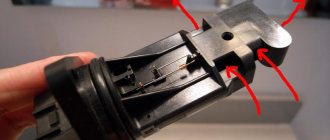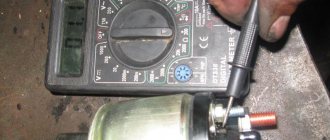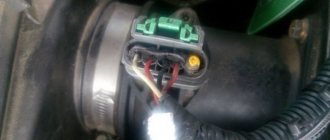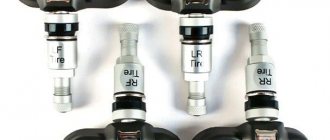Despite the variety of power plants of the VAZ 2110 (from carburetor ones, inherited from the V8, to limited versions with an Opel 150 l/s engine), we will focus on the more modern 8 and 16 valves with a volume of 1.6 liters. Questions about diagnosing and replacing the mass air flow sensor on a VAZ 2110 most often concern these particular internal combustion engines.
The German concern BOSCH produces several variants of flow meters for engines of this VAZ family: 0280218004, 0280218037 and 0280218116. The first option is practically not used, it can be easily replaced with a product with index 037. The only difference is in the design of the air measuring channel: on the new one (037) version, it is devoid of a childhood disease: uneven air intake for measurement.
The third option (116) is used on 16 valve VAZ 2110 equipped with a modern BOSCH-M7.9.7 or January 7 series controller.
Externally, these mass air flow sensors for the VAZ 2110 are practically the same, but installing 0280218116 instead of 0280218037 is not allowed, since the flow meters have different calibrations of the sensor readings relative to the air flow.
Therefore, owners of a VAZ 2110 with an 8-valve engine should install BOSCH 0280218037, and for 16-valve engines - BOSCH 0280218116. It is not necessary to look for products from a German manufacturer; for those who want to save money, there are analogues, including from Russian companies. Many of them actually produce only a housing with a measuring channel into which a set of sensors and a control board of the original Bosch are installed.
Information about the operation and design of the mass air flow sensor
Again, we will not consider the historically outdated mechanical options with a weather vane and the General Motors frequency flow meter, which was used in conjunction with the January 4-series ECU. Modern flow meters for the VAZ 10 series operate on the principle of a hot-wire anemometer.
It is based on the properties of some metals to significantly change resistance depending on heat (the MAF sensor uses an alloy of iridium with platinum, which causes the high cost of the device). There are two resistors in the air flow: one is precision, the second can change the resistance using heat. Voltage is applied to it, the thread is heated until it matches the standard. Depending on the strength of the air flow, the thread cools and the resistance changes. By increasing the voltage across the resistor, the temperature and, accordingly, the resistance are restored. This happens in real time, that is, the control of the air mass is constant. At the output, the mass air flow sensor displays the signal voltage with an accuracy of hundredths of a volt. The received information is processed by the ECU to accurately dose gasoline into the fuel-air mixture.
What happens if the flow meter breaks down? The engine will continue to operate, but in emergency mode. At idle speed without load, the speed will be set to 1500, power will be lost, and fuel consumption will increase. In some modes the motor may stall.
All elements are arranged into a single electronic model, which is placed in the measuring channel (air duct).
Symptoms of malfunction
There are several signs by which you can determine a malfunction of the mass air flow sensor:
- The check engine light comes on on the instrument panel;
- Fuel consumption increases noticeably;
- The car loses dynamics and power, failures occur when trying to increase engine speed;
- Difficulties arise when starting on a hot engine.
But what exactly causes these symptoms? The causes of sensor malfunction are as follows.
- The connector has lost contact.
- The air filter, grilles or sensor temperature detectors are dirty.
- Mechanical damage to sensor elements has occurred.
When the first signs of a malfunction occur, you should definitely check the mass air flow sensor, and then, depending on the situation, clean or replace the device.
Examination
Now let's talk about how to check our sensor. Today, two main methods of checking the mass air flow sensor are used.
- The engine is tested in operation with the mass air flow sensor disconnected. Simply turn off the power from the regulator and start the motor. When the mass air flow sensor is not present during startup, the electronic control unit turns on the power unit in emergency mode. The speed is adjusted to 1500 rpm. After disconnecting the sensor, drive a few kilometers and evaluate the dynamics and power. If the engine is running normally, then the sensor is the cause of the symptoms.
- The second method will require the use of a car tester or voltmeter. After starting the ignition, do not start the engine. The voltage threshold is set on the tester to 2V. The positive probe connects to the yellow wire on the sensor connector, and the black probe connects to the green wire. Next, refer to the table.
| Index | Air flow sensor condition |
| 0,99-1,02 | The sensor is functioning normally |
| 1,02-1,03 | Not ideal, but still acceptable voltage readings |
| 1,04-1,05 | Maximum permissible values that indicate imminent sensor failure |
| 1.05 or more | The air flow sensor has failed and needs to be replaced |
Prevention and testing of mass air flow sensor on VAZ 2110
As a preventive measure, we can recommend timely replacement of the air filter. The use of sports zeros shortens the life of the flow meter. In any case, regular cleaning of the air flow sensor will not hurt.
- We disconnect the sensor connector, having first removed the ground from the battery.
- Carefully unscrew the flow meter housing from the intake manifold flange.
- If dust deposits are detected, blow out the cavities with compressed air.
- Of course, you also need to clean the air duct and air filter box at the same time.
Tip: It is recommended to repeat this operation every time you replace the air filter.
If the contamination is severe (with oil and moisture), you can use a special cleaner for flow meters or carburetors; the manufacturer does not matter. To do this, it is necessary to direct the jet not only to visible sensors, but also to hidden cavities where the platinum resistor (thread) is located.
After this, the flow meter is installed in its regular place and the functionality of the electronic part is checked.
Testing and diagnostic methods
Shutdown
Pulling out the sensor is fairly easy. It is located in the air filter.
Article on the topic: Replacing a wheel bearing on a VAZ 2109 (video)
This method involves starting the motor with the sensor removed - we need to disconnect its connector. When turned off, the controller starts emergency mode, and new portions of the mixture are calculated based on the position of the damper. We need to drive a little, the speed should be above 1500 rpm. If the car behaves more dynamically without a mass air flow sensor, then the diagnosis is complete - it’s time to change the consumable.
Checking with a multimeter
This test requires that you have skills in using a multimeter (tester). The method is suitable for almost all VAZ models, including 2110. We need to take a multimeter and set it to a mode that measures constant voltage, which is usually designated DCV or only V. To work with the mass air flow sensor, you need to understand its pinout, it is as follows:
- Yellow, closest to the windshield, supplies current to the signal input;
- Green indicates ground;
- The pink or red-black wire comes from the main relay;
- The white-gray wire is responsible for the voltage output.
The location of the wires and their sequence.
Depending on the model, the colors may be different, but the location does not change. Here you will have to deal with a specific model. But once you find the input signal wiring (closer to the windshield) and grounding, you can do it without instructions. The wiring is clear, now you need to turn on the ignition without starting the engine. The tester sets a limit of 2 Volts. The black probe of the tester is connected to the green ground wire of the air flow sensor, and the red one is connected to the yellow one. The measurement takes place between two terminals. The probes must be inserted carefully; an additional needle is not required, since the probes can be freely inserted along the wires without damaging the insulation.
We look at the tester display. If the consumable is new, then there we will see a voltage indicator of 1.01. Over time, the indicator increases as the resistors wear out (the resistance drops). The larger the number, the greater the wear of the sensitive element:
- In good condition, the indicator will be 1.01… 1.02;
- With “normal” - 1.02... 1.03;
- The sensor will soon stop working – 1.03… 1.04;
- The dying state of the flow meter is accompanied by an indicator of 1.04… 1.05;
- Replacement of the unit is required when the reading is 1.05 or higher.
Testing the mass flow sensor. The dipstick must be inserted carefully.
Diagnostics can also be carried out without a multimeter. Instead, you can use the on-board computer. To do this, you need to go to the “voltage from the mass flow sensor” section; we are interested in the “U MAF” indicator.
Visual inspection
Here we need to carefully examine the surface of the corrugation and consumables. To check the condition, we need to loosen the air intake clamp at the outlet of the mass air flow sensor, and then pull it off. If you see traces of grease or condensation on the surface, then most likely they have damaged the unit. Sometimes the sensor can be “reanimated” by removing all the dirt. It ends up in the consumables due to rare changes of the air filter. If liquid appears on the sensitive element, this is a 90% failure. Lubricating oil enters due to a clogged oil separator or due to an increased level in the crankcase.
Article on the topic: Replacing the coolant in a VAZ 2110: boils, antifreeze disappears
Drops of oil on the sensor are a sure sign that it has failed.
If the above-described elements are detected, the diagnosis can be completed. If the surface is clean, move on. Remove the consumable from the air filter. It is held in place only by 2 screws, which are unscrewed with the 10th key. Looking at the photo, we see that there is an o-ring on the front of the mass flow sensor. It is installed for sealing - unfiltered air cannot leak through the inlet.
If this ring (in the photo it is green, but your color may be different) has slipped or remains in the filter housing, then a layer of dust can be found on the consumable mesh. Such a defect is enough to cause the sensitive element to fail. You need to assemble the unit according to the following scheme: check the reliability of the sealing skirt, put on the rubber ring, place the sensor in the air filter housing.
How to check the mass air flow sensor on a VAZ 2110 with a multimeter
Important! All disconnections and connections of connectors are made with the battery disconnected.
A. _ Checking the wiring harness and contacts. At this stage, the interaction between the ECU and the mass air flow sensor is tested. Performed with the connector removed and the ignition key in the “ON” position. You need to know the pinout of the sensor connector on the ECU side:
- Contact No. 1 is not involved in the test.
- Contact No. 2 - 12 volt power supply. A deviation of even 0.5 volts is not acceptable.
- Contact No. 3 - “ground”, mass.
- Contact No. 4 - 5 volt sensor power supply. Likewise: deviations are not allowed.
B. _ After making sure that the cable harness is intact and the ECU is working, we check the signal voltage on the connected flow meter. Turn the ignition key to the “ON” position and do not start the engine! We connect a digital multimeter to ground and contact No. 5 of the air flow sensor.
The multimeter is set to 2 volt measurement mode with an error of 1/100 volt. These readings accurately indicate the condition of the flow meter, so the accuracy class of the tester must be high.
If the device shows a voltage within 0.99-1.02 V, your flow meter is new or in excellent condition.
Readings from 1.03 to 1.05 volts are acceptable, but the air flow sensor will soon fail. You can still drive with such a sensor, but the quality of the fuel-air mixture will be far from ideal.
If there is no voltage or its level is above 1.05 V, the flow meter is faulty and requires replacement.
Advice: you should not skimp on replacing the mass air flow sensor. Excessive fuel consumption and increased engine wear will cover all the imaginary benefits.
How does the MAF work?
This device is a small wire made of platinum alloy. The size of this cord is only 70 microns. It is installed in a special tube, which is located in front of the throttle valve.
This wire is cooled under the air flow. To regulate the temperature between it and the air flow, electricity is applied to the wire. The charge level can be adjusted. The more the wire is blown, the more electricity is supplied.
Due to constant use, this wire is constantly covered in dirt. But modern sensors have a self-cleaning system. Dirt is one of the reasons why the device fails, but there are other signs of a malfunctioning MAF sensor. Although the design of the device is as simple and reliable as possible, it also fails. Its only drawback is that it is not suitable for repair. If the sensor fails, it is simply replaced with a new one.










